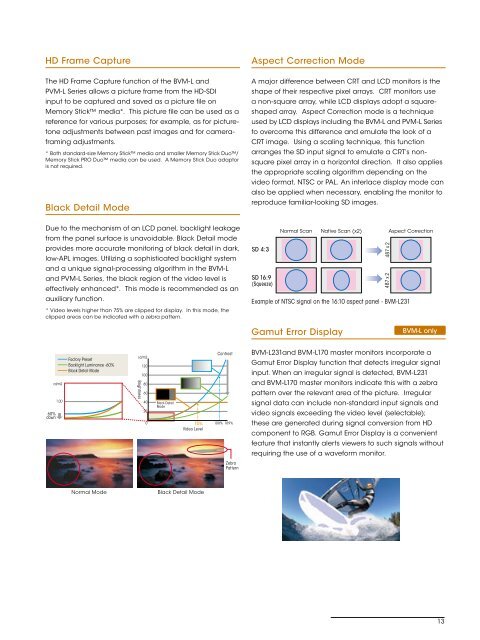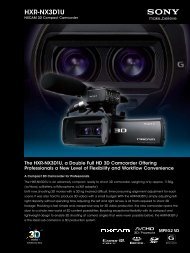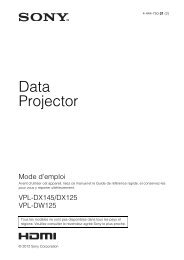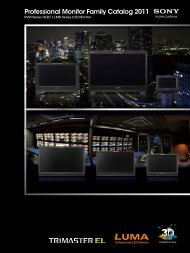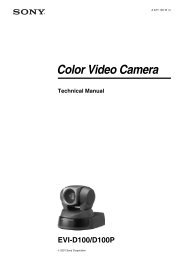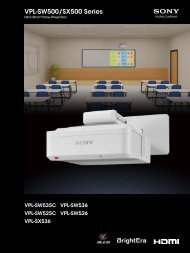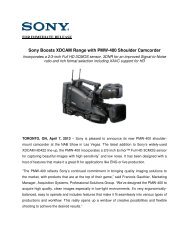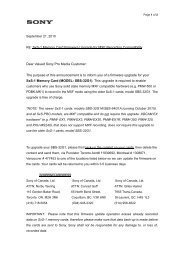BVM-L / PVM-L Series - Sony Professional Solutions Asia Pacific
BVM-L / PVM-L Series - Sony Professional Solutions Asia Pacific
BVM-L / PVM-L Series - Sony Professional Solutions Asia Pacific
Create successful ePaper yourself
Turn your PDF publications into a flip-book with our unique Google optimized e-Paper software.
HD Frame Capture<br />
The HD Frame Capture function of the <strong>BVM</strong>-L and<br />
<strong>PVM</strong>-L <strong>Series</strong> allows a picture frame from the HD-SDI<br />
input to be captured and saved as a picture file on<br />
Memory Stick media*. This picture file can be used as a<br />
reference for various purposes; for example, as for picturetone<br />
adjustments between past images and for cameraframing<br />
adjustments.<br />
* Both standard-size Memory Stick media and smaller Memory Stick Duo/<br />
Memory Stick PRO Duo media can be used. A Memory Stick Duo adaptor<br />
is not required.<br />
Black Detail Mode<br />
Due to the mechanism of an LCD panel, backlight leakage<br />
from the panel surface is unavoidable. Black Detail mode<br />
provides more accurate monitoring of black detail in dark,<br />
low-APL images. Utilizing a sophisticated backlight system<br />
and a unique signal-processing algorithm in the <strong>BVM</strong>-L<br />
and <strong>PVM</strong>-L <strong>Series</strong>, the black region of the video level is<br />
effectively enhanced*. This mode is recommended as an<br />
auxiliary function.<br />
* Video levels higher than 75% are clipped for display. In this mode, the<br />
clipped areas can be indicated with a zebra pattern.<br />
60%<br />
down<br />
-Factory Preset<br />
-Backlight Luminance -60%<br />
-Black Detail Mode<br />
cd/m2<br />
1.00<br />
cd/m2<br />
Brightness<br />
75%<br />
Video Level<br />
Normal Mode Black Detail Mode<br />
120<br />
100<br />
80<br />
60<br />
40<br />
20<br />
0<br />
Black Detail<br />
Mode<br />
Contrast<br />
100% 109%<br />
Zebra<br />
Pattern<br />
Aspect Correction Mode<br />
A major difference between CRT and LCD monitors is the<br />
shape of their respective pixel arrays. CRT monitors use<br />
a non-square array, while LCD displays adopt a squareshaped<br />
array. Aspect Correction mode is a technique<br />
used by LCD displays including the <strong>BVM</strong>-L and <strong>PVM</strong>-L <strong>Series</strong><br />
to overcome this difference and emulate the look of a<br />
CRT image. Using a scaling technique, this function<br />
arranges the SD input signal to emulate a CRT’s nonsquare<br />
pixel array in a horizontal direction. It also applies<br />
the appropriate scaling algorithm depending on the<br />
video format, NTSC or PAL. An interlace display mode can<br />
also be applied when necessary, enabling the monitor to<br />
reproduce familiar-looking SD images.<br />
SD 4:3<br />
SD 16:9<br />
(Squeeze)<br />
Normal Scan Native Scan (x2) Aspect Correction<br />
Example of NTSC signal on the 16:10 aspect panel - <strong>BVM</strong>-L231<br />
Gamut Error Display<br />
<strong>BVM</strong>-L231and <strong>BVM</strong>-L170 master monitors incorporate a<br />
Gamut Error Display function that detects irregular signal<br />
input. When an irregular signal is detected, <strong>BVM</strong>-L231<br />
and <strong>BVM</strong>-L170 master monitors indicate this with a zebra<br />
pattern over the relevant area of the picture. Irregular<br />
signal data can include non-standard input signals and<br />
video signals exceeding the video level (selectable);<br />
these are generated during signal conversion from HD<br />
component to RGB. Gamut Error Display is a convenient<br />
feature that instantly alerts viewers to such signals without<br />
requiring the use of a waveform monitor.<br />
487 x 2<br />
487 x 2<br />
<strong>BVM</strong>-L only<br />
13


